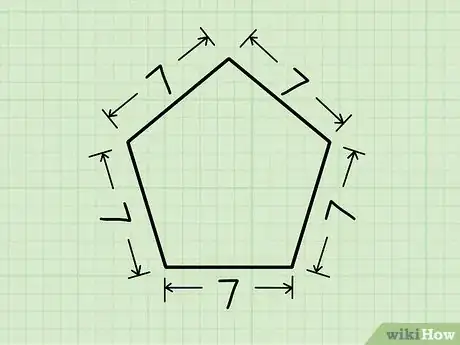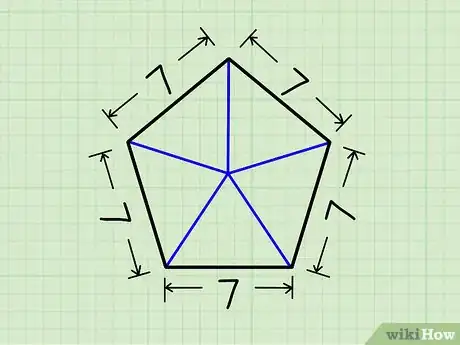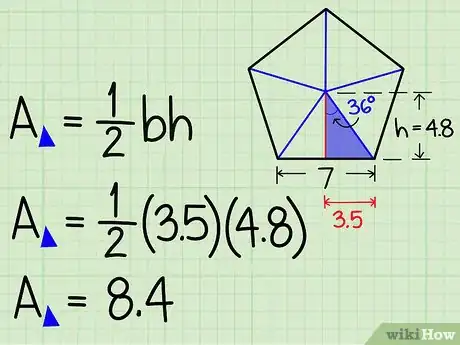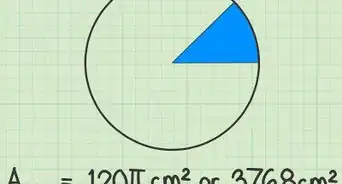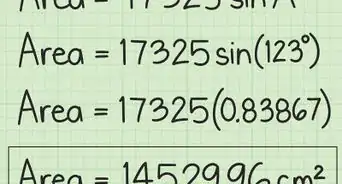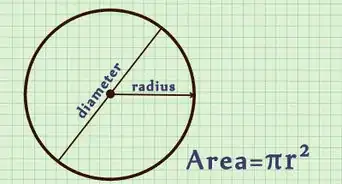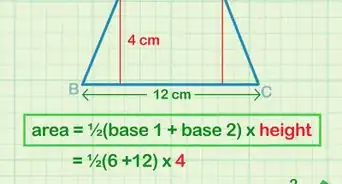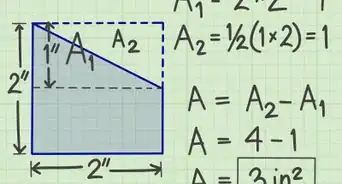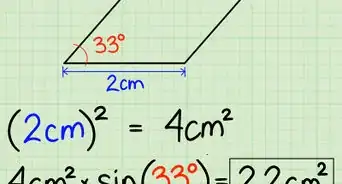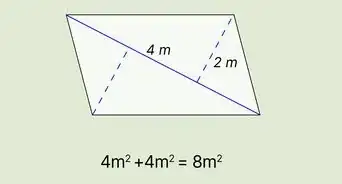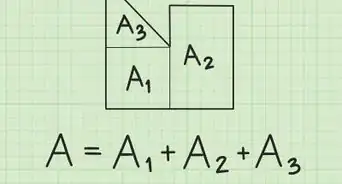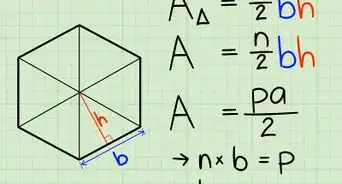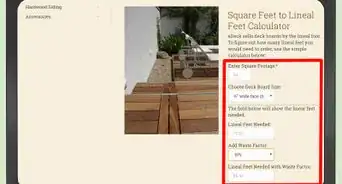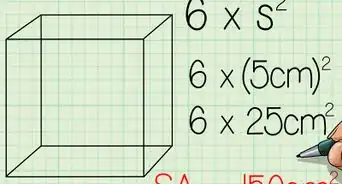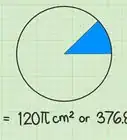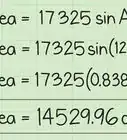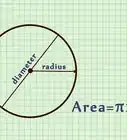This article was co-authored by Mario Banuelos, PhD. Mario Banuelos is an Assistant Professor of Mathematics at California State University, Fresno. With over eight years of teaching experience, Mario specializes in mathematical biology, optimization, statistical models for genome evolution, and data science. Mario holds a BA in Mathematics from California State University, Fresno, and a Ph.D. in Applied Mathematics from the University of California, Merced. Mario has taught at both the high school and collegiate levels.
There are 7 references cited in this article, which can be found at the bottom of the page.
This article has been viewed 788,667 times.
A pentagon is a polygon with five straight sides. Almost all problems you'll find in math class will cover regular pentagons, with five equal sides. There are two common ways to find the area, depending on how much information you have.
Steps
Finding the Area from the Side Length and Apothem
-
1Start with the side length and apothem. This method works for regular pentagons, with five equal sides. Besides the side length, you'll need the "apothem" of the pentagon. The apothem is the line from the center of the pentagon to a side, intersecting the side at a 90º right angle.[1]
- A regular pentagon can be divided into five triangles.[2]
- Where the height of the triangle is known as the apothem.[3]
- Then, using the apothem, the area of a regular pentagon will be ½ x apothem x 5.[4]
- Don't confuse the apothem with the radius, which touches a corner (vertex) instead of a midpoint. If you only know the side length and radius, skip down to the next method instead.
- We'll use an example pentagon with side length 3 units and apothem 2 units.
-
2Divide the pentagon into five triangles. Draw five lines from the center of the pentagon, leading to each vertex (corner). You now have five triangles.[5]Advertisement
-
3Calculate the area of a triangle. Each triangle has a base equal to the side of the pentagon. It also has a height equal to the pentagon's apothem. (Remember, the height of a triangle runs from a vertex to the opposite side, at a right angle.) To find the area of any triangle, just calculate ½ x base x height.[6]
- In our example, area of triangle = ½ x 3 x 2 = 3 square units.
-
4Multiply by five to find the total area. We've divided the pentagon into five equal triangles. To find the total area, just multiply the area of one triangle by five.[7]
- In our example, A(total pentagon) = 5 x A(triangle) = 5 x 3 = 15 square units.
Finding the Area from the Side Length
-
1Start with just the side length. This method only works for regular pentagons, which have five sides of equal length.
- In this example, we'll use a pentagon with side length 7 units.
-
2Divide the pentagon into five triangles. Draw a line from the center of the pentagon to any vertex. Repeat this for every vertex. You now have five triangles, each the same size.[8]
-
3Divide a triangle in half. Draw a line from the center of the pentagon to the base of one triangle. This line should hit the base at a 90º right angle, dividing the triangle into two equal, smaller triangles.[9]
-
4Label one of the smaller triangles. We can already label one sides and one angle of the smaller triangle:
- The base of the triangle is ½ the side of the pentagon. In our example, this is ½ x 7 = 3.5 units.
- The angle at the pentagon's center is always 36º. (Starting with a full 360º center, you could divide it into 10 of these smaller triangles. 360 ÷ 10 = 36, so the angle at one triangle is 36º.)
-
5Calculate the height of the triangle. The height of this triangle is the side at right angles to the pentagon's edge, leading to the center. We can use beginning trigonometry to find the length of this side:[10]
- In a right-angle triangle, the tangent of an angle equals the length of the opposite side, divided by the length of the adjacent side.
- The side opposite the 36º angle is the base of the triangle (half the pentagon's side). The side adjacent to the 36º angle is the height of the triangle.
- tan(36º) = opposite / adjacent
- In our example, tan(36º) = 3.5 / height
- height x tan(36º) = 3.5
- height = 3.5 / tan(36º)
- height = (about) 4.8 units.
-
6Find the area of the triangle. A triangle's area equals ½ the base x the height. (A = ½bh.) Now that you know the height, plug in these values to find the area of your small triangle.
- In our example, Area of small triangle = ½bh = ½(3.5)(4.8) = 8.4 square units.
-
7Multiply to find the area of the pentagon. One of these smaller triangles covers 1/10 of the pentagon's area. To find the total area, multiply the area of the smaller triangle by 10.
- In our example, the area of the whole pentagon = 8.4 x 10 = 84 square units.
Using a Formula
-
1Use the perimeter and apothem. The apothem is a line from the center of a pentagon, that hits a side at a right angle. If you are given its length, you can use this easy formula
- Area of a regular pentagon = pa/2, where p = the perimeter and a = the apothem.[11]
- If you don't know the perimeter, calculate it from the side length: p = 5s, where s is the side length.
-
2
-
3Choose a formula that uses radius only. You can even find the area if you only know the radius. Use this formula:[14]
- Area of a regular pentagon = (5/2)r2sin(72º), where r is the radius.
Community Q&A
-
QuestionHow do I find the perimeter of a pentagon when I'm only given the apothem?
 DonaganTop AnswererThe perimeter of a regular pentagon is the apothem multiplied by 7.267.
DonaganTop AnswererThe perimeter of a regular pentagon is the apothem multiplied by 7.267. -
QuestionWhat would be the length of a side of a regular pentagon with a perimeter of 12.5?
 DonaganTop AnswererEach side of a regular pentagon is one-fifth of the perimeter. So in this case, each side measures 12.5 / 5 = 2.5.
DonaganTop AnswererEach side of a regular pentagon is one-fifth of the perimeter. So in this case, each side measures 12.5 / 5 = 2.5. -
QuestionI am struggling to find the length of one side of a pentagon; two sides are 0.9 meters, 2 other sides at 0.53 meters each.
 DonaganTop AnswererThere is no formula available for finding a side of an irregular pentagon.
DonaganTop AnswererThere is no formula available for finding a side of an irregular pentagon.
References
- ↑ https://www.cuemath.com/measurement/area-of-pentagon/
- ↑ https://testbook.com/learn/maths-area-of-pentagon/
- ↑ https://testbook.com/learn/maths-area-of-pentagon/
- ↑ https://testbook.com/learn/maths-area-of-pentagon/
- ↑ https://www.cuemath.com/measurement/area-of-pentagon/
- ↑ https://www.cuemath.com/measurement/area-of-pentagon/
- ↑ https://www.cuemath.com/measurement/area-of-pentagon/
- ↑ https://www.varsitytutors.com/intermediate_geometry-help/how-to-find-the-area-of-a-pentagon?page=3
- ↑ https://www.varsitytutors.com/intermediate_geometry-help/how-to-find-the-area-of-a-pentagon?page=3
- ↑ https://www.mathsisfun.com/geometry/regular-polygons.html
- ↑ https://www.mathsisfun.com/geometry/regular-polygons.html
- ↑ http://www.mathopenref.com/polygonregulararea.html
- ↑ http://www.maths.surrey.ac.uk/hosted-sites/R.Knott/Fibonacci/simpleTrig.html
- ↑ http://www.mathopenref.com/polygonregularareaderive.html
About This Article
It’s easiest to find the area of a regular pentagon if you know the length of a side and the apothem. The apothem is a line that intersects one of the sides from the center of the pentagon at a 90° angle. For example, let’s say you have a pentagon with a side length of 3 units and an apothem of 2 units. You can now divide the pentagon into 5 triangles, each with a base width of 3 (equal to the length of one side of the pentagon) and a height of 2 (equal to the apothem). To find the area of the pentagon, all you need to do is find the area of one of the triangles and multiply the result by 5. Use the formula ½ x base x height to find the area of each triangle. In this example, ½ x 3 x 2 = 3, so each triangle has an area of 3 square units. Multiply 3 x 5 to get 15 square units, or the area of the entire pentagon. You can also use the formula Area = Pa/2, where P is the perimeter of the pentagon and a is the apothem. In the example above, the perimeter would be 3 x 5 = 15, and the apothem is 2. (15 x 2)/2 = 30/2, which is equal to 15. If you only know the side length of the pentagon, you can still figure out the area, but you’ll need to do a bit of trigonometry. Start by dividing the pentagon into 5 equal triangles, starting from a point at the center of the pentagon. The base of each triangle will be equal to the length of a side of the pentagon. Now, divide one of the triangles in half by drawing a vertical line from the vertex to the middle of the base to create two right triangles. You know that the base of the smaller triangle is ½ of the side length of the pentagon. So, if you have a pentagon with a side length of 7 units, the base of the smaller right triangle is 3.5 units. When you’re working with a regular pentagon, the angle at the top of this triangle will always be 36°. To find the height of the triangle, use the formula tan36° = b (base)/h (height) and solve for h. In our example, tan36° = 3.5/h. Multiply tan36° by h, then divide 3.5 by tan36° to find the height, which is approximately 4.8 units. Now you can plug the height into the formula for the area of a triangle, 1/2 x b x h, to find the area of the triangle. Plug in the base of the larger triangle for the b variable and the height you just found for the h variable to get ½ x 7 x 4.8 = 16.8 square units. Then, multiply the area of the larger triangle by 5 to get the full area of the pentagon, or 84 square units. Alternatively, you can plug the base width of the smaller triangle into the formula for the area of a triangle, then multiply the result by 10. Either way, you’ll get the same answer. You can also calculate the area from only the side length using the formula 5s2/4tan36°, where s is the length of one side of the pentagon. If you don’t have a calculator with a tangent function, don’t worry. Tan36° = √(5-2√5), so you can plug that into your calculations in place of tan36°. You can also figure out the area of a pentagon using only the radius, or r, which is the distance from the center of the pentagon to one of the corners, or vertices. To do this, use the formula 5/2 x r^2 x sin72°. For more on finding the area of a regular pentagon, including using formulas if you only know the length of a side or the radius, read on!




